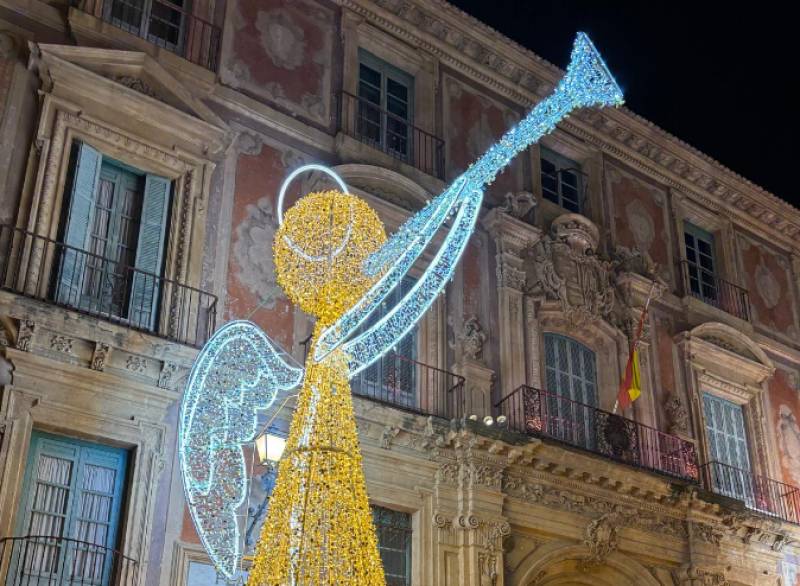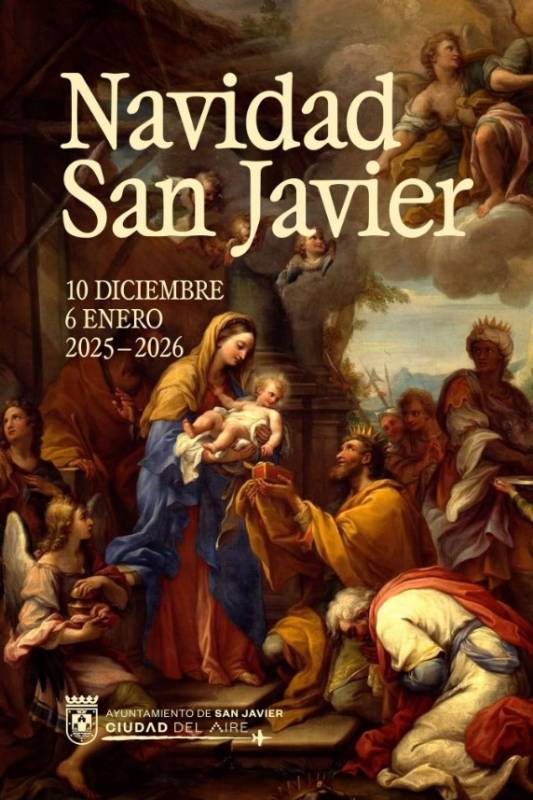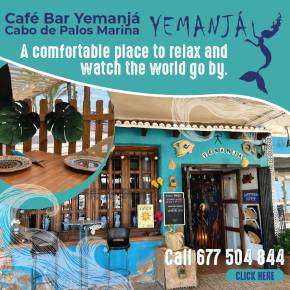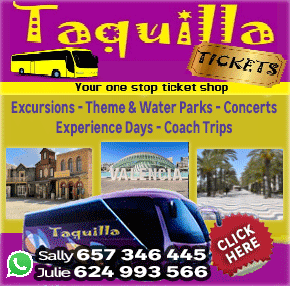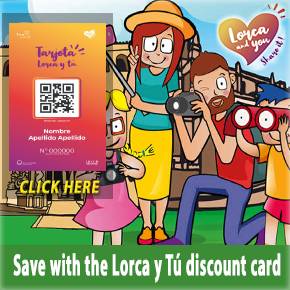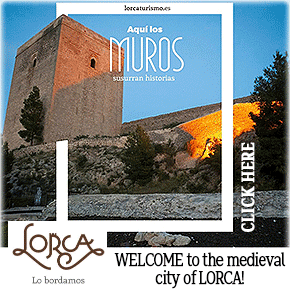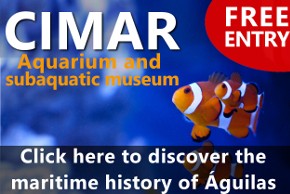- Region
- Águilas
- Alhama de Murcia
- Jumilla
- Lorca
- Los Alcázares
- Mazarrón
- San Javier
-
ALL AREAS & TOWNS
- AREAS
- SOUTH WEST
- MAR MENOR
- MURCIA CITY & CENTRAL
- NORTH & NORTH WEST
- TOWNS
- Abanilla
- Abarán
- Aguilas
- Alamillo
- Alcantarilla
- Aledo
- Alhama de Murcia
- Archena
- Balsicas
- Blanca
- Bolnuevo
- Bullas
- Cañadas del Romero
- Cabo de Palos
- Calasparra
- Camping Bolnuevo
- Campo De Ricote
- Camposol
- Canada De La Lena
- Caravaca de la Cruz
- Cartagena
- Cehegin
- Ceuti
- Cieza
- Condado de Alhama
- Corvera
- Costa Cálida
- Cuevas De Almanzora
- Cuevas de Reyllo
- El Carmoli
- El Mojon
- El Molino (Puerto Lumbreras)
- El Pareton / Cantareros
- El Raso
- El Valle Golf Resort
- Fortuna
- Fuente Alamo
- Hacienda del Alamo Golf Resort
- Hacienda Riquelme Golf Resort
- Isla Plana
- Islas Menores & Mar de Cristal
- Jumilla
- La Azohia
- La Charca
- La Manga Club
- La Manga del Mar Menor
- La Pinilla
- La Puebla
- La Torre
- La Torre Golf Resort
- La Unión
- Las Palas
- Las Ramblas
- Las Ramblas Golf
- Las Torres de Cotillas
- Leiva
- Librilla
- Lo Pagan
- Lo Santiago
- Lorca
- Lorquí
- Los Alcázares
- Los Balcones
- Los Belones
- Los Canovas
- Los Nietos
- Los Perez (Tallante)
- Los Urrutias
- Los Ventorrillos
- Mar De Cristal
- Mar Menor
- Mar Menor Golf Resort
- Mazarrón
- Mazarrón Country Club
- Molina de Segura
- Moratalla
- Mula
- Murcia City
- Murcia Property
- Pareton
- Peraleja Golf Resort
- Perin
- Pilar de la Horadada
- Pinar de Campoverde
- Pinoso
- Playa Honda
- Playa Honda / Playa Paraíso
- Pliego
- Portmán
- Pozo Estrecho
- Puerto de Mazarrón
- Puerto Lumbreras
- Puntas De Calnegre
- Region of Murcia
- Ricote
- Roda Golf Resort
- Roldan
- Roldan and Lo Ferro
- San Javier
- San Pedro del Pinatar
- Santiago de la Ribera
- Sierra Espuña
- Sucina
- Tallante
- Terrazas de la Torre Golf Resort
- Torre Pacheco
- Totana
- What's On Weekly Bulletin
- Yecla


- EDITIONS:
 Spanish News Today
Spanish News Today
 Alicante Today
Alicante Today
 Andalucia Today
Andalucia Today
ARCHIVED - March 31 to April 9 Semana Santa 2023 in Lorca, International Tourist Interest
Lorca celebrates Easter week in inimitably spectacular style
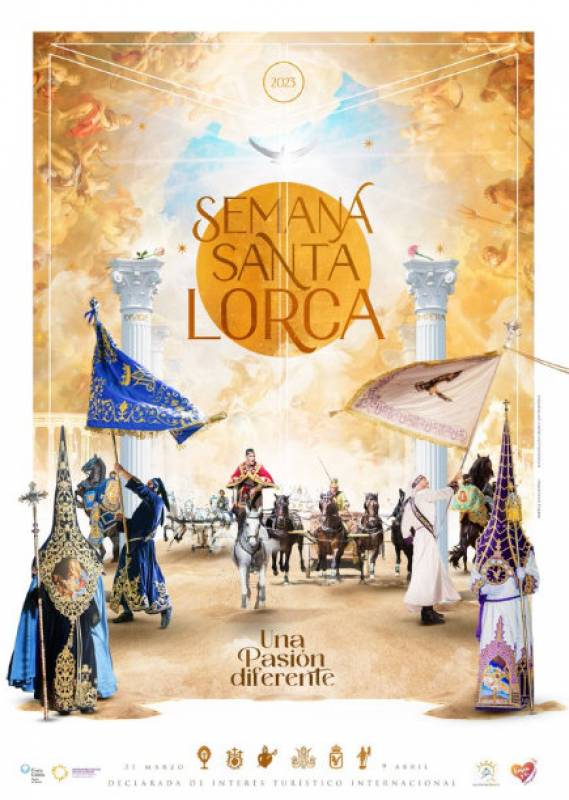 Semana Santa in Lorca is an extraordinarily flamboyant event, the most important element of which is the famed biblical processions, a unique manifestation of faith which features the exquisite embroideries for which the city is so famous.
Semana Santa in Lorca is an extraordinarily flamboyant event, the most important element of which is the famed biblical processions, a unique manifestation of faith which features the exquisite embroideries for which the city is so famous.
These are displayed throughout the year in the embroidery museums of the Cofradías (brotherhoods or guilds), and although the most spectacular pieces are the vast cloaks worn in the main biblical processions, the attention to detail in Lorca is mindboggling. Every robe, standard, cloak and capirote (the tall pointed hats worn by the penitents) is lavishly smothered in detailed embroidery and gold thread.
Although the biblical processions are the most famous element of Semana Santa in Lorca there are other unique events during this week, with a number of Via Crucis walks up to the Calvary high above the city, purple robed penitents dragging their wooden crosses up the steep steps, and numerous intimate “encuentros” and theatrical moments, where pasos meet in shaded squares and statues glide silently through darkened streets.
Tickets for seats in the stands which are set up along the routes of the biblical processions are available directly from the Cofradías, the Whites and the Blues (see below).
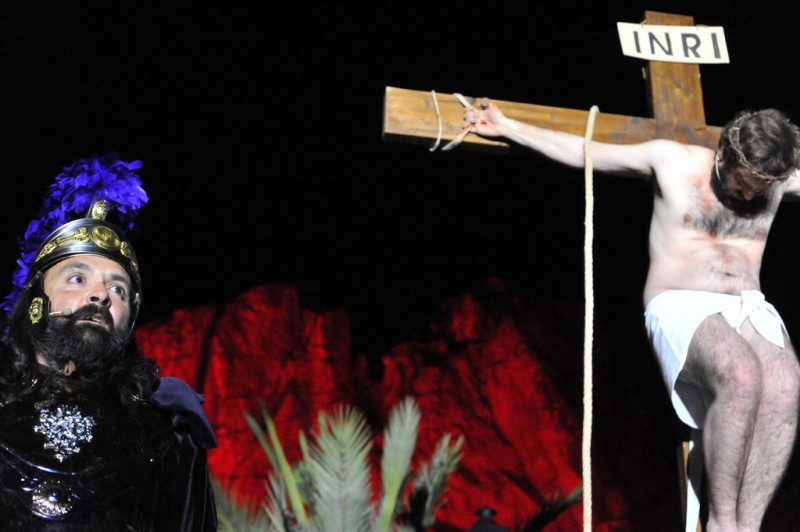
Main points of departure for orientation:
Paso Blanco (ticket sales). Calle Santo Domingo, 8. Opening hours Monday to Wednesday 11am to 2pm and 4.30pm to 7pm, Thursday and Friday 11.30am to 2.30pm. Click for map, Calle Santo Domingo, Lorca.
Paso Morado (no ticket sales). Iglesia del Carmen, Calle Nogalte. Monday to Wednesday 10.30am to 1.30pm and Thursday and Friday 11am to 2pm, Click for map, Calle Nogalte, Lorca.
Paso Encarnado (no ticket sales). Parroquia de San Cristóbal, Rincón Macho. Open Thursday and Friday 11am to 2pm Click for map, Rincón Macho Lorca.
Paso Azul (ticket sales), Iglesia de San Francisco, calle Nogalte 7. Opening times Monday to Wednesday 11am to 2pm and 5pm to 8pm, Thursday and Friday 10am to 3pm. Click for map, Iglesia de San Francisco Calle Nogalte, Lorca.
Click here for details of the Lorca Tourist Office.
Full information about the embroideries of Lorca can be found here.
Information about what to visit, the monuments and history of Lorca as well as plenty of practical information about the city can be found on the Lorca Today website and further guided tours this week in the feed below.
PROGRAM FOR SEMANA SANTA LORCA 2023 (NB Images do not necessarily relate to the specific day.)
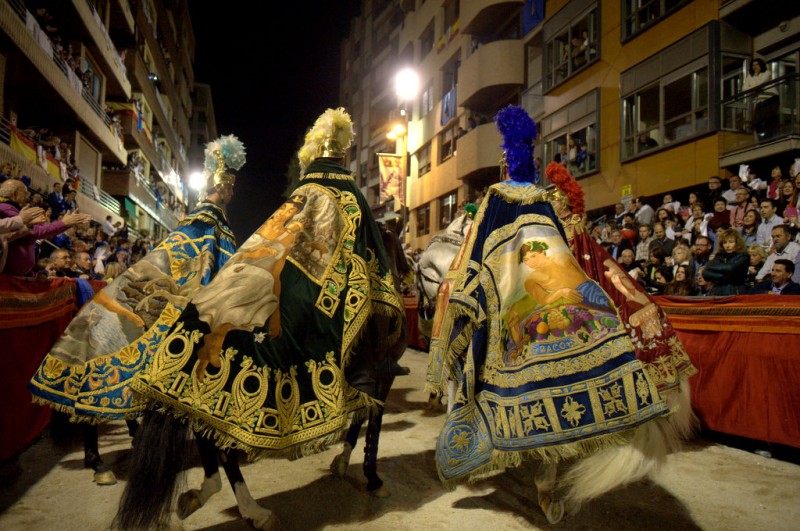
NOTE: ALL TIMINGS ARE PROVISIONAL PENDING CONFIRMATION AND PROCESSIONS ARE SUSCEPTIBLE TO CANCELLATION IN THE EVENT OF ADVERSE WEATHER CONDITIONS
Friday March 31, Viernes de Dolores (Friday of Sorrows)
Midnight of Thursday night: on the stroke of midnight at the door of the Church of San Francisco, the headquarters of the Paso Azul, the Serenata to the Virgen de los Dolores is performed, a song to begin Semana Santa and welcome in her holiest day. Thousands of members of the Paso Azul gather to join in, making this the “bluest night of the year” in Lorca!
7.30: Vía Crucis of the Paso Encarnado, the Santísimo Cristo de la Sangre. The walk to the hill known as the Calvary in Lorca begins at the Iglesia de San Cristóbal and ends at the Parroquía de San Diego, where the Cristo de la Sangre remains until the following Tuesday.
16.30: Vía Crucis Penitencial to mark the end of Lent (Paso Morado). Leaving the Colegio de San Francisco, which is the site of the first Station of the Cross, the Paso Morado climb up to the Calvary with the image of the Virgen of los Dolores created by sculptor Marcos Laborda, from Caravaca de la Cruz, in the late 18th century. Hooded penitents in in purple robes carry large wooden crosses, and at the top of the climb is one of the most unexpected sights in Lorca, with fabulous views out cross the city.
19.30: Mass in the church of San Francisco in honour of the Santísima Virgen de los Dolores.
19.30: Vía Crucis of the Santísimo Cristo de la Sangre, following a route from the church of San Cristóbal to the church of San Diego.
19.30: Procesión de la Virgen de los Dolores (Paso Azul). Departure from the Iglesia de San Francisco via Cuesta de San Francisco, Príncipe Alfonso, Lope Gisbert and Floridablanca, entering the main street of Avenida de Juan Carlos I at approximately 20.00.
This is the first of the main processions of the week and includes some of the elements of the biblical parade and a number of horsemen, as well as all of the “pasos” of the blues. Also included are the six embroideries belonging to the Paso Azul which have been declared Items of Cultural Interest.
The Paso Blanco contribute the “Triumphant entry of Constantino into Rome” and the Roman soldiers, while the female members of the Paso Azul wear traditional “mantilla” shawls and accompany the Virgen de los Dolores.
Tickets for seats cost 5 euros and can be purchased directly from the two main Cofradías, Blancos or Azules.
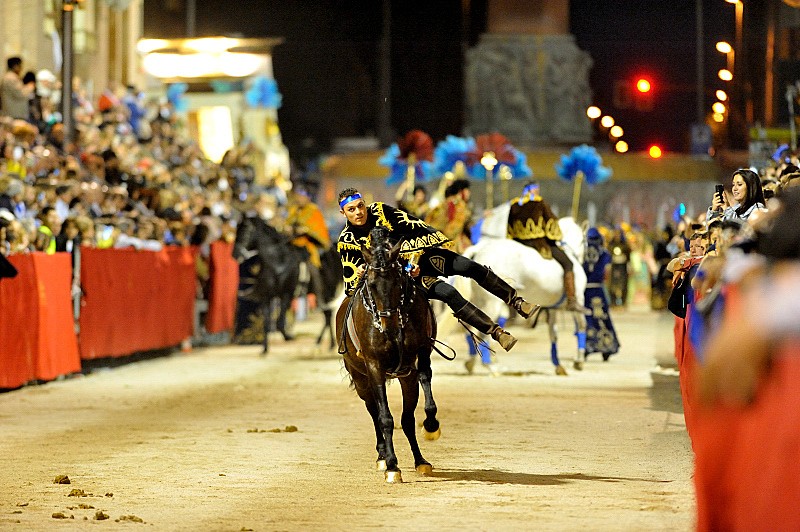
Saturday April 1, Sábado de Pasión (Passion Saturday)
20.30: In the Iglesia de San Francisco the “Salve” hymn is performed in honour of the Virgen de los Dolores. The salve was written in 1903 by José Antonio Navarro, chapel master of Córdoba Cathedral, and this is the only day of the year on which this piece of music can be heard.
21.15: Mass in honour of the Virgen de la Soledad (the patron of the Paso Negro) in the former Collegiate Church of San Patricio.
21.45: Procesión de la Soledad, presided over by the Hermandad de la Curia (Paso Negro). Leaves from the Iglesia de Santiago and follows a route through the old town of Lorca: Calle Santiago, Villaescusa, Marsilla, Plaza del Ibreño, Porche de San Antonio, Zapatería, Rojo, Cava, Plaza de España. The procession lasts for approximately one hour.
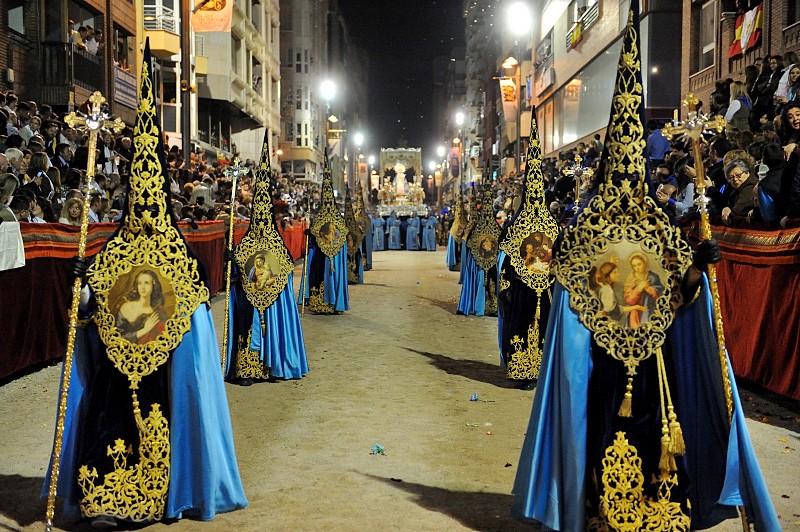
Sunday April 2, Domingo de Ramos (Palm Sunday)
10.15: Mass in commemoration of the Triumphant Entry of Jesus into Jerusalem, in the Capilla del Rosario (Paso Blanco). 15 minutes prior to this the palms which will be carried in the evening procession are blessed.
11.30: Blessing of the olive branches and palms which will be carried in the evening procession, in the square known as Placica Nueva, alongside Calle Nogalte.
12.00: Blessing of the Palms in the church of San Cristóbal (Paso Negro).
12.00: The three standards of the Paso Blanco enter the Capilla del Rosario and are then taken to their collection points for the evening.
19.30: Procesión de las Palmas (Paso Negro). The participants gather in the Plaza de España and follow a route along Álamo, Lope Gisbert, Príncipe Alfonso and Óvalo de Santa Paula before entering the main thoroughway of the Avenida Juan Carlos I at around 20.00. It then continues on Floridablanca, Lope Gisbert and Álamo, before ending back in the Plaza de España.
Seats cost 5 euros and can be purchased from the Paso Azul and the Paso Blanco.
This parade is the first to include some elements of the spectacular biblical procession of Good Friday evening, notably the Triumphant Entry of Jesus into Jerusalem of the Paso Blanco, which made its début in 1855. It’s probably the best evening to go if you don´t want to buy a full price seat for the main biblical processions, as there are enough elements to make it an exciting occasion and the horsemen are more reckless on this night than any other!
Following the main procession, thousands of participants dressed as shepherds and townsfolk from Jerusalem follow, waving their palms and olive branches to welcome Christ.
The Paso Azul parade with the Pharaonic group, a colourful and exotic troupe which includes the sacred sun boat of Ramses II carried by slaves.
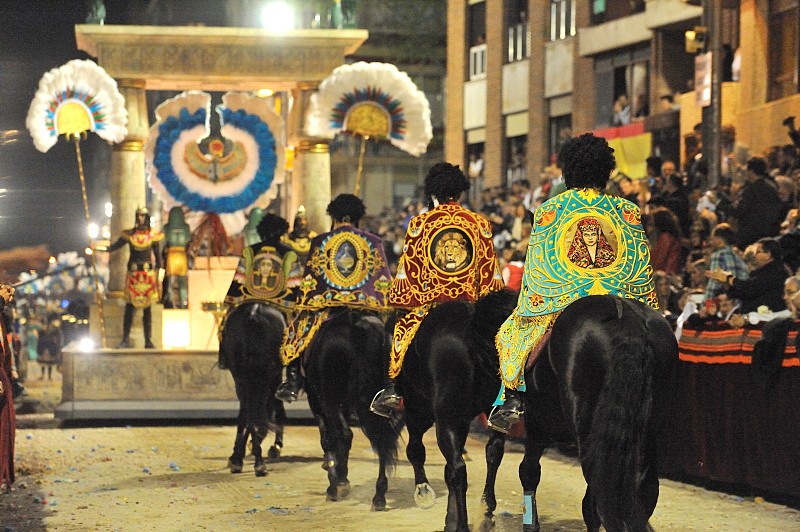
Monday April 3, Lunes Santo (Holy Monday)
11.30: In the headquarters of their brotherhoods the Paso Blanco and Paso Azul put on exhibitions during the week, showing some of the most incredible pieces of embroideries which can be seen during Semana Santa. These special exhibitions at the two museums (the Mubbla and the Museo Azul) officially open at 11.30 on the Monday and remain open until Friday.
For the rest of the week the exhibition at the Museo Azul opens from 11.00 to 20.00, closing for lunch between 14.00 and 17.00, while the MuBBla is open from 11.00 to 14.00 and 16.30 to 19.00. On Maundy Thursday and Good Friday shorter opening hours are in place to prepare for the processions: MuBBla 11.30 to 14.30, Museo Azul 10.00 to 15.00.
During the evening the Paso Encarnado opens its own exhibition in the Capilla del Rosario.
20.30: Representation of the living Vía Crucis. This follows the 14 Stations of the Cross, leaving from Calle Corredera, in front of the Iglesia de San Francisco, and ending in front of the small church on Monte Calvario. It's a well attended event, the streets packed as the events of the Passion are played out.
20.30: Prayer of the Rosary in honour of Nuestra Señora La Virgen de la Amargura in the Capilla del Rosario.
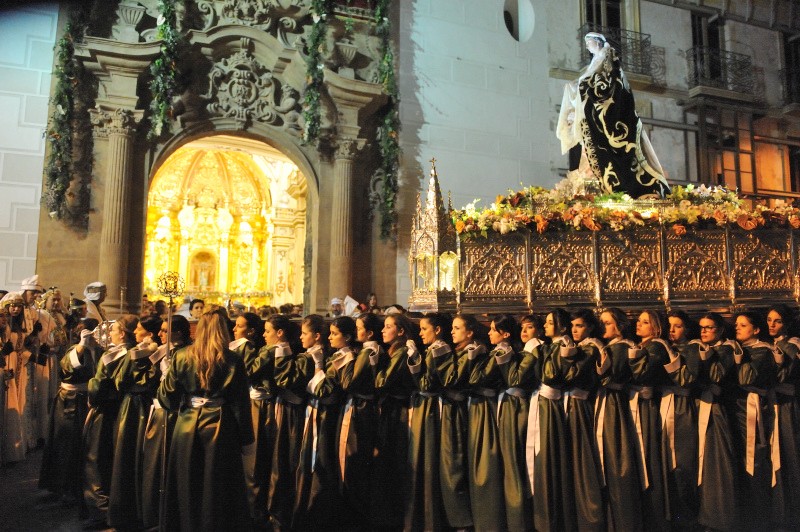
Tuesday April 4, Martes Santo (Easter Tuesday)
10.30: The embroidery museums open their Semana Santa exhibitions.
20.30: Prayer of the Rosary in honour of Nuestra Señora La Virgen de la Amargura in the Capilla del Rosario.
21.00: The figure of Cristo de la Sangre leaves the church of San Diego prior to the start of the evening procession.
21.15: Nuestro Señor Jésus de la Penitencia leaves the church of San Cristóbal.
21.30: It is the turn of the Santísima Virgen de la Soledad Coronada to depart from the church of San Cristóbal.
22.00: The three processions and tableaux meet in an emotional “Encuentro” in the Plaza de la Estrella, marking the official start of the Procesión del Santísimo Cristo de la Sangre.
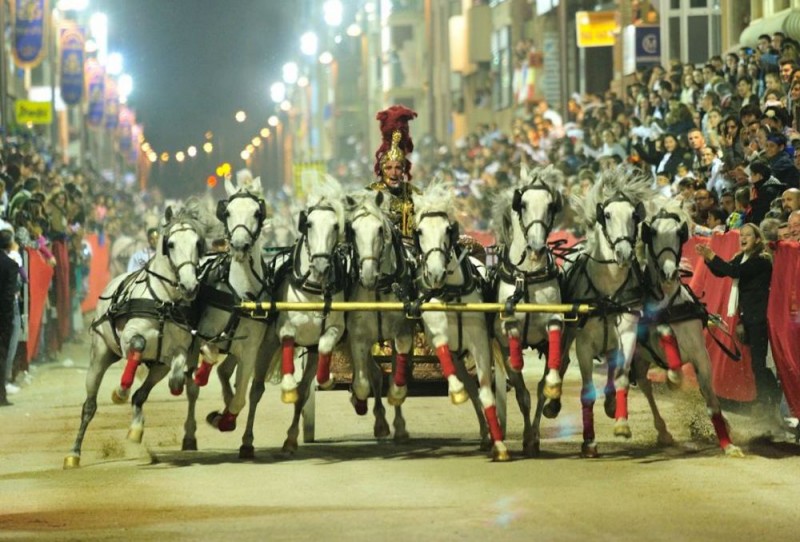
Wednesday April 5, Miércoles Santo (Easter Wednesday)
10.30: The embroidery museums open their extraordinary Semana Santa exhibitions.
20.30: Prayer of the Rosary in honour of Nuestra Señora La Virgen de la Amargura in the Capilla del Rosario.
23.00: The figure of Christ crucified is carried by the Hermanos del Socorro from the church of La Misericordia on the hill of Calvary above the city centre to the Iglesia Parroquial del Carmen in the Penitential Descent of Cristo de la Misericordia.
As the figure exits the church saetas are sung by the moonlight and the procession is lit by torches. On arrival at the Iglesia del Carmen, saetas are once more sung. (Paso Morado).
Midnight: The Paso Morado exhibit the figure of Nuestro Señor Jesús Nazareno at the door of the Iglesia del Carmen, where more Saetas are performed by singers from Lorca and all over Spain (Paso Morado).
Midnight: A serenade is sung to the Santísima Virgen de la Soledad Coronadaat the door of the Iglesia de San Cristóbal, with the participation of the Agrupación Musical del Santísimo Cristo de la Sangre (Paso Encarnado).
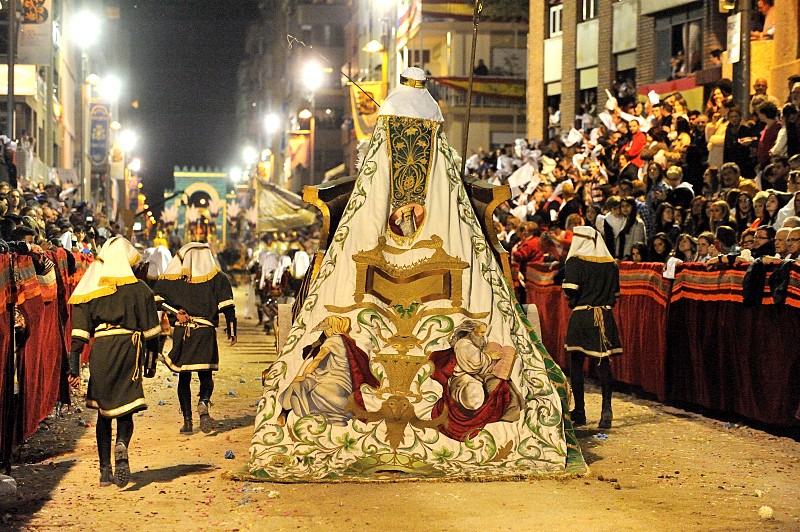
Thursday April 6, Jueves Santo (Maundy Thursday)
10.30: The embroidery museums open their extraordinary Semana Santa exhibitions.
19.30: The Procesión del Perdón, presided over by the Paso Morado.
This first major biblical processions concerns the might of Rome and the persecution of early Christians in the Empire, the domination of the Egyptians, the paso of the Last Supper and the suffering of Jesus before his crucifixion. It's not the biggest procession of all - Friday is more spectacular and contains ALL of the biblical elements, whereas this procession only contains some of them. However, some tickets are valid for both nights, so friends could share the cost!
Leaving from the Iglesia del Carmen at 19.30, the procession follows Calle Nogalte, Lope Gisbert and Floridablanca and reaches the main area and the stands of Juan Carlos I at around 20.00. Leaving here, the procession goes along Avenida de Portugal and Nogalte, concluding back at the Iglesia del Carmen.
23.30: Procession of Silence, presided over by the Paso Encarnado. Leaves from the Iglesia de San Cristóbal, and passes through the major streets of the district: calles Portijico, Escalante, Abellaneda, Mayor and Plaza de la Estrella and Plaza Hortalizas.
This is a strictly religious event which takes place in a silence which is broken only by the sounds of saetas (a type of song sung by a one voice) at various points along the way.
Midnight: Vía Crucis de Penitencia. A candlelit procession from the first Station of the Cross, which is at the doorway of the Colegio de San Francisco, lasting right through the night as numerous groups form to walk up to the hill of Calvary. The figure of the Cristo de la Misericordia accompanies the first group on his way back to his permanent home.
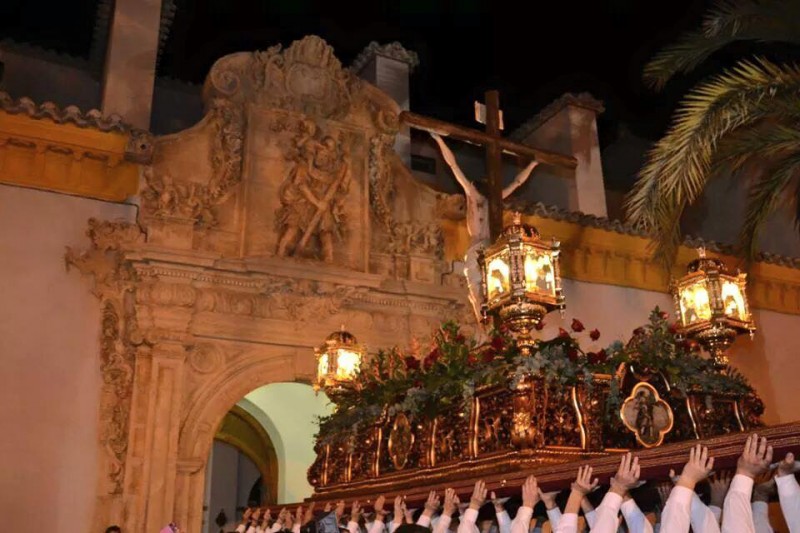
Friday April 7, Viernes Santo (Good Friday)
10.30: Procesión Penitencial del Vía Crucis. This austere Paso Morado procession leaves from the Colegio de San Francisco, the first station of the cross, and is one of the oldest processions of which records exist in Lorca. From here it heads up towards the Ermita de la Misericordia, located on the hill known by the locals as Monte Calvario.
Hundreds of penitents in purple tunics with crosses on their chests accompany the pasos of San Juan Evangelista, La Virgen de los Dolores, Nuestro Señor Jésus Nazareno del Socorro on their journey along the Vía Crucis, dragging their wooden crosses with them.
A "rezaor" recites traditional prayers, passed down verbally from one generation to thenext since the 18th century, describing each of the Stations of the Cross. This event has been taking place in Lorca since the 17th century.
17.00: Mass in the Iglesia de San Cristóbal and the Iglesia del Carmen.
19.30: The main biblical procession of Lorca, presided over by the Paso Blanco.
This spectacular event begins in the Capilla del Rosario and forms up along Calles Lope Gisbert, Príncipe Alfonso, and Santa Paula, entering Avenida Juan Carlos I via the Óvalo de Santa Paula at approximately 20.00. It is the most important parade of the week - hence the price of the tickets - and is a truly extraordinary sight.
It’s beyond description, and for visitors to the Region of Murcia over Easter the seats are well worth the money. Each of the cloaks in this procession, the robes, the standards and the shawls worn by the sculptures, is hand embroidered, and they are exquisite works of art in their own right. Alongside these are horse-drawn carriages, which race up the street at full pelt, cloaks flaring behind them, and hundreds of horsemen, each wearing a richly embroidered cloak.
In amongst all of this the crowd scream their support for the Blues and the Whites, and if you can afford the tickets this is a unique spectacle and expression of faith and fervour which should be seen at least once by everyone living in, or visiting, the Region of Murcia.
The procession is headed by the Paso Encarnado and the Paso Morado, followed by the Paso Azul and the Paso Blanco with the Paso Negro sandwiched in between. It is the single event with the most complete selection of the standards, shawls, cloaks and other embroidered items which are the first textiles in Spain to be awarded Item of Cultural Interest status.
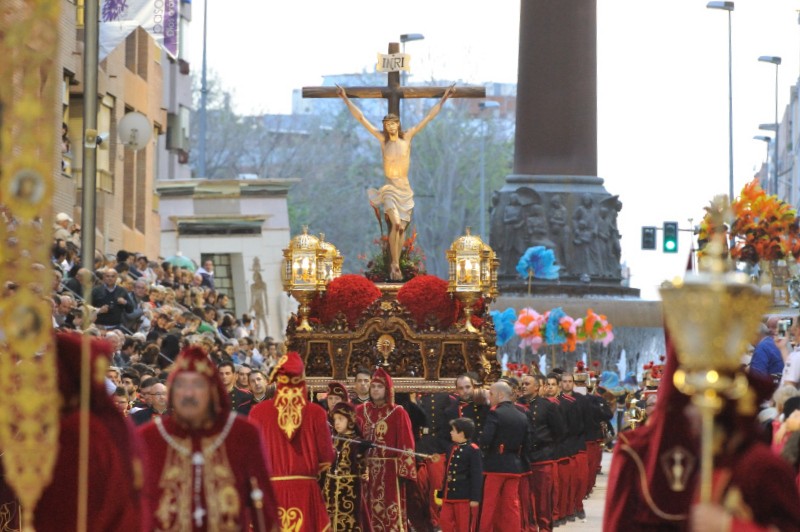
Saturday April 8, Sábado de Gloria (Easter Saturday)
11.00: The floral decoration of the platforms on which the images of the Virgen de la Encarnación and Nuestro Señor Jesús Resucitado are carried begins at the Ex-Colegiata de San Patricio. At the same time, the façades of the buildings in the Plaza de España are decorated ready for the resurrection.
21.00: Easter Vigil begins in the churches of San Patricio, the Virgen del Carmen and San Cristóbal, as does the Procession of the Virgen de la Encarnación (starting at the church of San Patricio and heading for the Iglesia de Santa María la Mayor, where the Virgen spends the night).
In addition, the figure of straw representing Judas is burnt in the Plaza de España as a prelude to Easter Sunday, an event which has been traditional in Lorca since the 18th century.
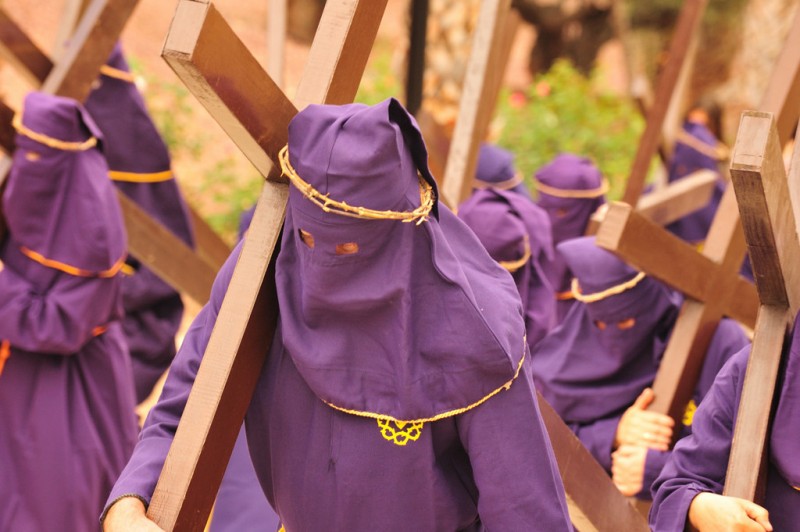
Sunday April 9, Domingo de Resurrección (Easter Sunday)
11.30: Procesión del Resucitado. Leaves from the church of San Patricio and takes the following route: Álamo, General Eytier, Granero, Fernando el Santo, Alfonso X, Corredera, Álamo, arriving back at the recently reopened Excolegiata de San Patricio at approximately 13.00.
The splendour of the last Semana Santa procession in Lorca is epitomized by the figure of Nuestro Señor Jesús Resucitado, the honorary Mayor of Lorca, carried on the shrines of bearers clad in white tunics and showered with petals along the route. All of the main standards of the Cofradías accompany the statue, along with their bands, as the bells chime in the streets on this day of glory and celebration.
At the end of the procession, Holy Mass is celebrated in the Plaza de España.
20.30: Solemn Salve to the Virgen de la Amargura in the Capilla del Rosario, with a floral offering.
Oficina de Turismo de Lorca

The rich and extensive history of Lorca has left a legacy of archaeological sites, and historic buildings, around which the modern city has built its tourism industry. Among these are Lorca Castle, the Jewish quarter of the castle and synagogue, Plaza de España, Colegiata de San Patricio, Museo de Arqueologico Municipal, Iglesia de San Francisco, Casa Huerto Ruano, Palacio de Guevara, Iglesia de San Mateo, Pósito de los Panaderos, Convento Virgen de las Huertas, Antiguo Convento de la Merced, Iglesia del Carmen and the Teatro Guerra.
 Unfortunately Lorca has also been prone to natural disaster, suffering a Gota Fría on September 28th 2012, as well as two earthquakes measuring 5.3 and 5.5 on the Richter scale on 11th May 2011, claiming 9 lives. Since this earthquake the city has been rebuilding, winning recognition for its Lorca, Open for Restoration initiative, which used the restoration of the city as a tourist attraction whilst it rebuilt its historical buildings, some of which are currently still not open.
Unfortunately Lorca has also been prone to natural disaster, suffering a Gota Fría on September 28th 2012, as well as two earthquakes measuring 5.3 and 5.5 on the Richter scale on 11th May 2011, claiming 9 lives. Since this earthquake the city has been rebuilding, winning recognition for its Lorca, Open for Restoration initiative, which used the restoration of the city as a tourist attraction whilst it rebuilt its historical buildings, some of which are currently still not open.
The tourist office relocated for 14 years to Calle San Patricio, near the church, but has now returned to its former premises alongside the Palacio de Guevara in the Plaza Concha Sandoval, or Plaza de la Bordadora (click for map).
Lorca also has an area of coastline incorporating the Parque Regional de Cabo Cope - Puntas de Calnegre, in the Sierra de Almenara, which includes the beaches of Puntas de Calnegre, Baño de las Mujeres, San Pedro, El Siscal, Cala Honda, Cuartel del Ciscar, Junquera, Cala de la Gruta, Cala Leña, Los Hierros, Cala Blanca and Playa Larga, although many are accessible only along difficult tracks or by boat!

However, in spite of its many attractions, the name of Lorca is synonymous with Easter, (Semana Santa) its biblical parades of International Tourist Interest status and famous throughout Spain. The week includes a series of processions in which the Whites (Paso Blanco) and Blues (Paso Azúl) try to outdo each other with the magnificence of their embroideries and the skill and daring of their horsemen.
Lorca also has a Parador hotel, located within the historic castle.
Opening hours for Lorca tourist office:
Every day of the year apart from 1st and 6th January and 25th December, 10.00 to 14.00 and 16.30 to 18.30 (except Sunday afternoons).
These opening times are often extended and other information points created during the Semana Santa celebrations.
For more local news, events and visiting information go to the home page of Lorca Today
See what's on in Lorca:
Cartagena
El Carmoli
Islas Menores and Mar de Cristal
La Manga Club
La Manga del Mar Menor
La Puebla
La Torre Golf Resort
La Union
Los Alcazares
Los Belones
Los Nietos
Los Urrutias
Mar Menor Golf Resort
Pilar de la Horadada
Playa Honda / Playa Paraiso
Portman
Roldan and Lo Ferro
San Javier
San Pedro del Pinatar
Santa Rosalia Lake and Life resort
Terrazas de la Torre Golf Resort
Torre Pacheco
Aledo
Alhama de Murcia
Bolnuevo
Camposol
Condado de Alhama
Fuente Alamo
Hacienda del Alamo Golf Resort
Lorca
Mazarron
Puerto de Mazarron
Puerto Lumbreras
Sierra Espuna
Totana
Abaran
Alcantarilla
Archena
Blanca
Corvera
El Valle Golf Resort
Hacienda Riquelme Golf Resort
Lorqui
Molina de Segura
Mosa Trajectum
Murcia City
Peraleja Golf Resort
Ricote
Sucina
Condado de Alhama
El Valle Golf Resort
Hacienda del Alamo Golf Resort
Hacienda Riquelme Golf Resort
Islas Menores and Mar de Cristal
La Manga Club
La Torre Golf Resort
Mar Menor Golf Resort
Mazarron Country Club
Mosa Trajectum
Peraleja Golf Resort
Santa Rosalia Lake and Life resort
Terrazas de la Torre Golf Resort
La Zenia
Lomas de Cabo Roig
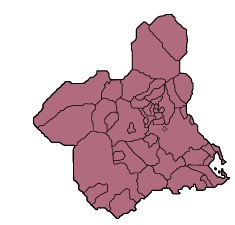
CAMPOSOL TODAY Whats OnCartagena SpainCoronavirusCorvera Airport MurciaMurcia Gota Fria 2019Murcia property news generic threadWeekly Bulletin










